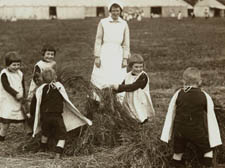|
|
 |
| |

Some of the Foundling Hospital Children at Summer Camp, in the 1920s |
Little orphan lives revived
An exhibition at the Foundling Museum tells the story of four abandoned children, recreating their lives in heart-rending detail, writes Sunita Rappai
MERCY Draper, aka Foundling 2767, was born Elizabeth Chambers on October 24, 1756 in the parish of Castle Eaton, Wiltshire.
She was “the bastard daughter of Anne”, according to the parish records available.
The illegitimate and unwanted child was taken to the Foundling Hospital the following month – one of 13 babies accepted on the day that she arrived – and promptly renamed, according to hospital policy.
Few details remain about the rest of her life. She was blind, perhaps from birth or, more probably, as a result of the smallpox she contracted in 1760, aged four. She possessed “a very fine voice”, receiving music tuition while at the hospital. And, remarkably, she enjoyed a successful musical career for several years until a diagnosis of mental illness confined her to an asylum for the rest of her life.
Mercy’s is one of four foundling stories that come under the spotlight at a new exhibition called Foundling Lives at the Foundling Museum in Bloomsbury, located next door to the site of the original Foundling Hospital which was demolished in 1926.
Established in 1739, after a long, heroic struggle by founder Thomas Coram, the Foundling Hospital was London’s first home for abandoned children.
Coram, a successful shipbuilder and sailor, had been horrified by the poverty he saw on London’s streets and was especially struck by the fate of the thousands of unwanted children, often abandoned to die.
Over two and a half centuries, the hospital cared for more than 27,000 children. Among their number was Paul Holton, who entered the hospital in January 1760 – not long after Mercy Draper – and was one of the few children who succeeded in being adopted. As a result, he avoided the stigma often attached to foundlings, eventually becoming a successful businessman, an alderman and then the chief magistrate of Wokingham.
John Brownlow, aka foundling number 18607 and another remarkable success story, was just three months old when he was admitted to the hospital in 1800.
Brownlow became a hugely influential administrator and advocate for the hospital and one of its defining chroniclers and is widely believed to be the inspiration for Dickens’s “kindly Mr Brownlow” in Oliver Twist.
But there were sadder stories too. While life as a foundling was preferable to abandonment and many of the hospital’s practices were progressive for their time, the regime was also harsh and disciplined.
Children were not always nurtured and were often made to feel inferior for their supposed good fortune.
The final child of the four featured in the exhibition is Joe Ormiston who was taken to the new Foundling School in 1938, aged five, by
his foster mother. He remained there for a further six years, and his at times heart-rending story details the effects of that environment on him.
Through photographs, film footage, artefacts and personal memories, Foundling Lives movingly and painstakingly, brings the hospital and the experiences of these children to life.
As the exhibition concludes, Joe’s story is a poignant reminder that Captain Coram’s struggle is still relevant.
The moral imperative of our individual and collective responsibility for our children, it says, is no less urgent today than it was in 1739.
|
 |
|
| |
|
 |
|

